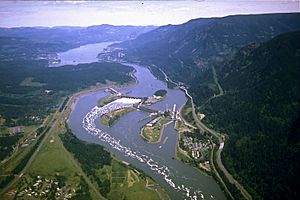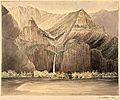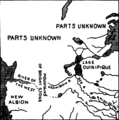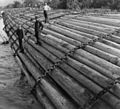Columbia River facts for kids
The Columbia River is the largest river in the Pacific Northwest of North America. It starts in Canada, flows through Washington, and then forms much of the border between Washington and Oregon. Finally, it empties into the Pacific Ocean.
This mighty river is about 1,243 miles (2,000 km) long. Its biggest branch, called a tributary, is the Snake River. The area of land that drains into the Columbia River, known as its drainage basin, is huge! It's about the size of France. This basin covers parts of seven US states and one Canadian province. The Columbia River carries more water than any other North American river flowing into the Pacific Ocean.
For thousands of years, the Columbia River and its branches have been very important to the people and economy of the region. People have used the river for travel since ancient times, connecting different groups. The river system is home to many types of fish that travel between fresh water and the salty ocean. These fish, especially salmon, were a main food source for the native peoples.
Contents
River History
In the late 1700s, an American ship was the first non-native vessel to enter the river. A British explorer followed, sailing past the Oregon Coast Range into the Willamette Valley. Later, companies involved in the fur trade used the Columbia as a key route for moving goods.
Explorers traveling by land entered the Willamette Valley through the beautiful but tricky Columbia River Gorge. Soon, pioneers began to settle in the valley in larger numbers. Steamships on the river connected communities and helped with trade. When railroads arrived in the late 1800s, many built along the river, they added to these important connections.
River Development
Since the late 1800s, both government groups and private companies have greatly changed the river. To help ships and barges travel, locks have been built along the lower Columbia and its branches. Also, dredging has made shipping channels wider and deeper.
Since the early 1900s, many dams have been built across the river. These dams help generate electricity, make travel easier, provide water for irrigation, and control floods. The 14 hydroelectric dams on the main part of the Columbia River, plus many more on its tributaries, produce over 44% of all the hydroelectric power in the United States!
Nuclear power has also been produced at two places along the river. For many years, materials for nuclear weapons were made at the Hanford Site. These changes have greatly affected the river's environment. This includes pollution from industries and barriers that stop fish from migrating.
Dams on the Columbia River
In 1902, the United States Bureau of Reclamation was created to help develop dry areas in the western states. One of its big projects was building the Grand Coulee Dam. This dam was meant to provide water for irrigation to a large area in central Washington called the Columbia Basin Project. When World War II started, the focus of dam building shifted to making electricity. After the war, irrigation efforts continued.
In the 1960s, the United States and Canada signed the Columbia River Treaty. This agreement focused on controlling floods and getting the most electricity from the river downstream. Canada agreed to build dams and create reservoirs to store water. In return, the United States agreed to share half of the extra electricity benefits with Canada. Canada built three dams to meet its part of the agreement, with the last one finished in 1973.
Today, the main part of the Columbia River has 14 dams. Three of these are in Canada and 11 are in the US. Four dams on the main river and four on the lower Snake River have navigation locks. These locks allow ships and barges to travel from the ocean. The entire river system has more than 400 dams in total. These dams help with many things like flood control, navigation, managing water flow, storing water, and creating hydroelectric power.
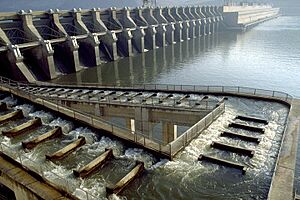
Building these dams changed the river's landscape and natural environment a lot. The Columbia River was once one of the best places in the world for salmon. Fishing spots that were once very active, like Celilo Falls, have seen a big drop in fishing over the last century. Salmon populations have also gone down a lot. To help the fish, fish ladders have been built at some dams. These ladders help salmon swim upstream to their spawning grounds. However, Chief Joseph Dam has no fish ladders, which completely blocks fish from traveling to the upper part of the Columbia River system.
Major River Branches
| Tributary | Average water flow: cubic feet per second (m³/s) |
|---|---|
| Snake River | 56,900 (1611) |
| Willamette River | 35,660 (1010) |
| Kootenay River (Kootenai) | 30,650 (867) |
| Pend Oreille River | 27,820 (788) |
| Cowlitz River | 9,200 (261) |
| Spokane River | 6,700 (190) |
| Deschutes River | 6,000 (170) |
| Lewis River | 4,800 (136) |
| Yakima River | 3,540 (100) |
| Wenatchee River | 3,220 (91) |
| Okanogan River | 3,050 (86) |
| Kettle River | 2,930 (83) |
| Sandy River | 2,260 (64) |
Images for kids
-
The Columbia River Gorge facing east toward Beacon Rock
-
Drumheller Channels, part of the Channeled Scablands formed by the Missoula Floods
-
Panoramic view of Columbia River Gorge from Dog Mountain in Washington
-
Chief Joseph of the Nez Perce people
-
Multnomah Falls, painted by James W. Alden, 1857
-
Carver's map from 1778, showing the River of the West, New Albion, Lake Winnipeg, and the Mountains of Bright Stone
-
Columbia River, Cascade Mountains, Oregon, (1876) by Vincent Colyer (oil on canvas). Beacon Rock is visible on the left.
-
Map of Lewis and Clark's journey.
-
The mouth of the Columbia is just past Astoria, Oregon; ships must navigate the tricky Columbia Bar to enter or exit the river.
-
The sternwheeler Hassalo runs the Cascades Rapids, May 26, 1888. These rapids are now underwater due to the Bonneville Dam.
-
A huge Benson log raft, carrying a year's worth of logs, heads downriver in 1906.
-
Salmon die after spawning. Eagle Creek in Oregon, November 2007.
-
Nuclear reactors at the Hanford Site along the river.
-
Near The Gorge Amphitheatre in George, Washington.
See also
 In Spanish: Río Columbia para niños
In Spanish: Río Columbia para niños


